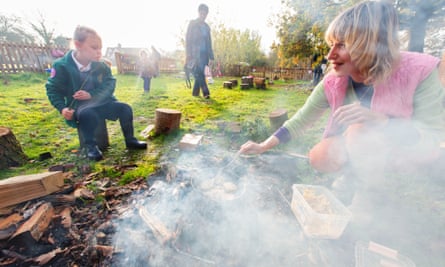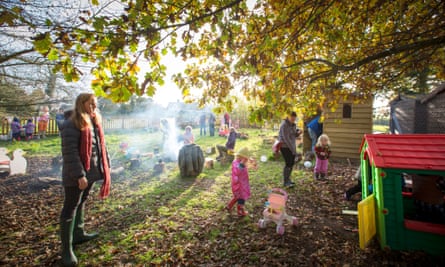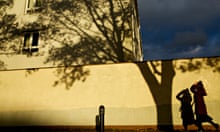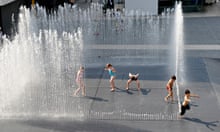Golden leaves are falling, wood smoke is rising, and my daughter Milly finds a dressing-up box incongruously placed in a small paddock, puts on a silky pink top and sunhat and climbs a tree.
Below her, one boy waves a toy plastic chainsaw at another. “I’m going to chop you,” he says. “It’s a tool, not a weapon,” says his mum, making sure he is safe. Parents are shivering in the cold but no children are complaining.
This is Dandelion forest school, one of a growing number of outdoor nurseries, where children learn through outside play, all year round. Open fires, messing around with tools, outdoor toilets and outside in rain and snow: it may sound like a cruel punishment for cotton-wool kids, but forest schools are quietly spreading through Britain, with almost no assistance from the authorities.
With antecedents in Robert Baden-Powell’s scouts, the Woodcraft Folk and Margaret McMillan’s outdoor nurseries, today’s movement was kickstarted by Bridgewater College, which established the first forest school in Somerset in 1993 after an inspiring trip to Danish nurseries run on Scandinavian friluftsliv (“open air life”) principles. The Forest School Association charity has since helped 12,000 teachers and other professionals undertake forest school training. In Worcestershire alone, there are 360 “forest schools”, mostly primary schools, which typically give pupils one woodland learning experience each week.
Like many parents, I’m keen for my three-year-old twins to experience the freedoms I enjoyed roaming wild as a small boy, and avoid the incessant screens and invitations to consume that come with indoor life. But my girls have quite different personalities – Esme loves mucking about outside while Milly prefers indoor play – so I wasn’t sure how they would enjoy an open day at Dandelion, an off-grid nursery that opens next to Erpingham primary school (itself a forest school) in Norfolk in January.
Dandelion is purist: there is no indoors. Instead, there is a fire, a tree to climb, a sink where children can make mud pies, a tunnel of willow shoots containing a doll’s house, a mini-stage made from pallets, a shed for a toilet and a purple tent for quiet time, heated by a woodburner.
Emma Harwood, an experienced primary school teacher, is opening Dandelion with fellow teacher Hayley Staniforth-Room, after they became convinced of the merits of child-centred learning outdoors. “Both Hayley and I have chosen to leave primary school because we believe in this really strongly,” says Harwood, cooking Welsh cakes on the open fire. “I love teaching reception but we’re closing the door – literally – and moving towards more testing. It doesn’t feel child-centric enough any more.” After taking primary schools on weekly forest school sessions, Harwood noticed a huge difference in pupils’ “self-esteem and ability to assess risk and make their own decisions”.

The forest school movement does not fetishise the outdoors but has a philosophy of child-led learning, with a focus on all the senses. Teacher-to-child ratios are never more than one-to-six. In Harwood’s sessions, children sing around the fire, learn to use and make tools, build dens, dig in the mud, identify bugs with magnifying glasses or retreat to the tent for reading and puzzles.
When I call Caroline Watts, who runs the Forest Kindergarten in a National Trust wood near Sevenoaks, Kent, her children are feeding sugar-water to a tired bumblebee. “We’re also looking for mushrooms,” she says. “Our classroom is constantly changing, which is what I love about it.” Earlier, they made lassos, climbed onto a ship (a tree stump) and used their lassos to rescue (imaginary) sheep. “I’m amazed by their autonomy,” says Watts. “They’ve become more and more competent physically and play more and more imaginatively.”
It sounds idyllic and yet triggers a frenzy of parental fretting: what about the fire? The tools? And most of all, what about the cold?
Many forest school websites repeat a brusque aphorism variously attributed to Scandinavians, Sir Ranulph Fiennes and Alfred Wainwright: there is no such thing as bad weather, only inappropriate clothing. But suitable clothing is expensive (although in Norfolk, Harwood has scoured charity shops for shrunken cashmere jumpers for her pupils) and some children really do feel the cold more than others.
“Parents worry about the cold but if they can do it in Norway, in -10C, we can do it here,” reasons Watts. One child, however, left the Forest Kindergarten because “he was getting ill so much we thought it wasn’t fair,” she says, although she is convinced that being outside means her children are less likely to pass around illnesses.
What about the fire and the tools? “Every day, we risk-assess,” says Harwood. She was surprised how quickly children grasped fire safety. “We hugely underestimate what children can do.” Tree-climbing and tool-use is closely supervised. “Children are going to get stung by nettles, they will get caught on brambles,” she says. “Parents understand that to learn and develop, you will occasionally have accidents. Having said that, in seven years working with [forest school] reception classes, I haven’t had anything other than cuts and bruises.”
By Dandelion’s climbing tree, another mum, Lois Povey, watches her son, Tom. “He goes to a nursery at the moment and for four weeks in a row, they didn’t go outdoors,” she says. “Tom is so happy outdoors. He was outside this morning [in November] in his pyjama top and no pants, playing with his boats in the paddling pool.” Povey used to be a teacher and wants Tom to avoid her experience. “Everything is so structured and prescriptive and involves tests. This lets them get outside and learn without realising they are learning, through unstructured play.”
Jon Cree, chair of Forest School Association, agrees that the popularity of forest schools is, in part, a reaction against the contemporary testing culture. Forest schools have fallen victim to public sector cuts – until recently, a number of local authorities employed staff to develop forest school sessions in mainstream schools but all but one has lost their job. And yet the movement is growing in Britain and beyond. Cree recently visited South Korea and found 40% of its kindergartens undertaking some form of forest school education. “They want to move it into their very regimented primary and secondary schools,” he says.

“Every parent likes the idea of their children being outside more”, says Harwood, but many are initially sceptical about its educational benefit. “I’ve certainly met a lot of parents who thought it [forest school] was a waste of time but I’ve never met a parent who after their child attended hasn’t said, ‘Wow, that really made a difference’.” Is there hard evidence that being outdoors inspires better learning? Most studies have looked at forest school’s positive impact on confidence and dispositions for learning. “We know from anecdotal evidence that forest schools help literacy and numeracy but we need more evidence,” says Cree. A Scottish study recently found activity levels 2.2 times higher in a forest school day than during a school day that included PE lessons.
Like any conventional nursery, forest school nurseries are inspected. Ashdon Preschool Forest School in Saffron Waldon, Essex was the first completely outdoor nursery to be inspected by Ofsted. Inspectors judged it “good” but withheld an “outstanding” rating because children had too few opportunities to “turn on and operate information and communication and technology equipment”.
“They said the way round it is to get some cameras so we’re going to do that,” says Sue Cowling, a supervisor at Ashdon. But she is resisting tablets. “I don’t think it’s the right place for iPads. Most of the children have got access to it [communications technology] at home so do they really need it here?”
Despite fears that the forest school movement is not well-served by Ofsted, when Forest Kindergarten in Sevenoaks was inspected this year it was rated “outstanding”: Caroline Watts provides technology in the form of cameras and torches.
Will a forest school nursery prepare my daughters for modern primary schools – and the technologically-obsessed modern world? “There’s a definite fear among parents about getting their children ready for school at a younger age but all the evidence says that’s not what they need,” says Watts. “Reception teachers say the main thing children need is resilience, and bringing them to the forest teaches them resilience. We should be making schools ready for children rather than make children ready for schools.”
At Dandelion, Emma Harwood also offers reassurance. Her two sons were brought up forest school-style: one is a writer, the other is a physicist who works in the City. “At forest school, children learn to think, question and justify what they think and that’s a much better stepping stone into commerce or engineering,” she says. “Clearly children will be what they are. We just give them the best equipment to do it.”
By the end of our session at Dandelion, to my surprise, indoorsy Milly is still playing outside while mud-loving Esme has retreated to the security of the warm tent. Wondering so much about how forest school will benefit them, I hadn’t paused to consider its positive impact on parents: on the journey home, both girls conk out, fast asleep after so much fresh air and exercise.





Comments (…)
Sign in or create your Guardian account to join the discussion